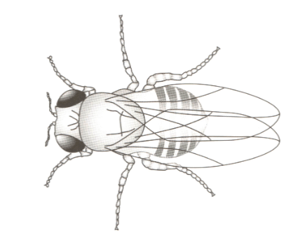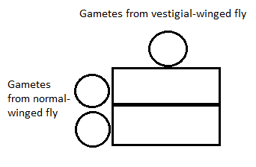Cell M is a cell in the body of an animal. It contains two set of chromosomes. Each set is made up of 16 chromosomes.
The cell divides by mitosis to produce cells P and Q
How many chromosomes are there in cell P?
Important Questions on Inheritance
Cell M is a cell in the body of an animal. It contains two sets of chromosomes. Each set is made up of 16 chromosomes.
The cell divides by mitosis to produce cells P and Q
Are cells P and Q genetically different, genetically identical to the parent cell?
Cell M now divides by meiosis.
Outline three differences between the division of meiosis and mitosis.
State three features, visible in figure 16.2, that show that the fruit fly is an insect.

Fruit flies can have normal wings or vestigial (really small) wings. The allele for normal wings, N, is dominant. The allele for vestigial wings, n, is recessive.
Complete the table to show the possible genotype and phenotypes for fruit fly wings. Be very careful to write the letters N and n so that there is no doubt whether each one is a capital letter or a small letter.
| Genotype | Phenotype |
Complete the genetic diagram to predict the genotypes and phenotypes of the offspring of a heterozygous normal-winged fly and a vestigial-winged fly.
Phenotypes of parents: normal wings vestigial wings
Genotypes of parents: _____ _____
Gametes: _____ and _____ all _____

